The making of Half-Life 2: Valve takes us behind the scenes of its narrative masterpiece
Gabe Newell, Marc Laidlaw, and more sit down with Edge Magazine for a behind the scenes exploration of Half-Life 2
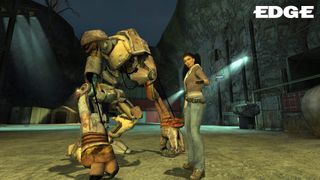
It's difficult to get anyone at Valve to tell you that Half-Life 2 was a great game. Its staff are quick to credit their competitors with a similar will for innovation, and are reticent to posit themselves as sole pioneers. Though they acknowledge the pile of awards the game has amassed, the column inches, the forums gushing with praise, none of this is an end in itself but feedback to be analysed, fuelling the continual effort to become better at what Valve already does and loves doing.
"It helps if you don't have expectations that might make it hard to hear the reactions you are getting," says Gabe Newell, Valve's co-founder and figurehead, when we ask if and when he knew the company had created something special. Such evasion would normally strike you as false modesty, but Valve is a company of unorthodox methods – a company without job titles run like a school for the gifted, a company with such a close commitment to its community that it reads every email, a company that, with the slow gestation of Steam, has become something of a saviour of PC gaming with seeming reluctance.
Its decisions are often unfathomable, veering from The Orange Box's incredible value, through the endless care and attention given to the Team Fortress 2 community, to the more difficult proposition of selling two Left 4 Dead games in quick succession. Valve is outspoken and perhaps even eccentric, Newell's own proclamations on the "total disaster" of PS3 or on Microsoft's indolent support of PC gaming provoking headlines. Externally, its catalogue may appear near-infallible – but these triumphs have been hard won. The original Half-Life was scrapped and revised over a period of 12 months before release. With its publisher threatening to drop marketing support shortly after the game hit shelves, Valve was not guaranteed to even recoup its investment until it persuaded Sierra to release a Game Of The Year edition.


This feature first appeared in Edge Magazine #216. If you want more like it every month, delivered straight to your doorstop or your inbox, why not subscribe to Edge here.
Half-Life 2's development was similarly rocky, most frequently waylaid by Valve's own towering aspirations – and perhaps this is why Newell is reluctant to sing its praises, even after the fact. Nothing is certain in game development, not even at Valve. Newell himself nixed the scheduled appearance of the game at E3 2002 when the proof-of-concept reel failed to blow him away (he had consciously distanced himself from the project in order to maintain an unbiased first viewing of it). Then the game missed its much-trumpeted September 30, 2003 ship date – a debacle which saw the company lose internal momentum as well as public face, and has solidified Newell's commitment to avoiding specific dates whenever possible. The disaster was shortly followed by a security scandal in which a German hacker leaked the not-even-nearly finished code, causing further dismay at a studio already spending $1 million per month to complete the game.
Even as the final pieces fell into place, a legal battle with publisher Vivendi Universal Games threatened to scupper Valve's efforts. Originally, Valve had sued Vivendi, claiming the publisher had illegally distributed Counter-Strike licences to internet cafés. Vivendi's counter-suit was the thing of nightmares: Valve had not, Vivendi alleged, been diligent in finishing Half-Life 2; it felt that the creation of Steam undermined its right to publish Valve's games.
There were worries that Vivendi would refuse to release Half-Life 2 until six months after it had gone gold. Vivendi relented and the courts ruled in the studio's favour – but it's proof that Valve's alchemical triumphs are the result of a little serendipity as well as perseverance and talent. It may have had the benefit of self-funding, its founders' ample reserves accumulated during the ascendency of Microsoft, but it took brass balls to see the making of Half-Life 2 through without compromise. Perhaps this is also why so few games have managed to surpass Half-Life 2's achievements. As Newell says, "Making games is hard, and every team has to pick their battles carefully."
Creating one of the greats

Valve's chosen battle was simply to make the greatest PC game of all time. Its vectors of attack were multiple: skirmishes which saw the medium as a whole gain ground in the implementation of physics, develop new ways of telling stories in interactive spaces and, most fundamentally, aspire to a higher level of maturity.
Sign up to the GamesRadar+ Newsletter
Weekly digests, tales from the communities you love, and more
Half-Life 2's characters are engaging both dramatically and in action: they are a tangible presence in the world which help or hinder the player directly. And the world itself, with its Eastern Bloc urban austerity and sense of abandon in its rural desolation, is a fictional construct considerably evolved from the first game's satirical shlock – a coherent place which, regardless of the player's narrow corridor of progress through it, never once fails to convince. "There was a period when the first-person genre was relegating the experience to that of a shooting gallery," Newell says. "There have been plenty of games that point to a much broader range of options – environment and character development, storytelling, gameplay, tone – and Half-Life 2 was part of that."
That part being the vanguard, presumably. But it wasn't that it got there first – Half-Life 2 isn't just an important iteration in the onward progress of the first-person shooter, it remains a high-water mark in many respects. At the time, the presence of the handheld physics toy, the gravity gun, was thought to be the most significant addition, but, even though Valve's brilliantly playful implementation was a great differentiator from games past, the physical manipulation of the environment was an inevitability in the industry, an advance born of the unstoppable sweep of technology. The game's aspiration of communicating a grown-up narrative, through engaging with its characters and setting, was as much a product of imagination as it was technology, and it is this credential which has proved much harder for other games to match. Even BioShock, with its smart meta-commentary on the freedom of the player, follows a little meekly in the footsteps of Half-Life 2, in which your nemesis mocks your popular calling as "The Free Man" and asks if you can really do anything but destroy.
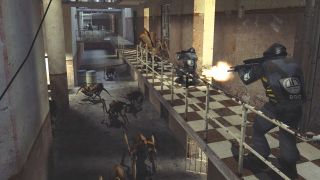
It is still, of course, a story about alien invasion, largely articulated through the exchange of gunfire. But Half-Life 2 showed, more profoundly than other shooters of its decade, that narrative wasn't just the backdrop to action, but spawned by a constant interplay with the 3D interactive space. The germ of this sophistication was evident in the game's predecessor, from its ostentatious scene-setting on the Black Mesa transit system, to Barney the security guard offering to buy you a beer after work. Although the scientists and guards were little more than props to be sucked into air vents or diced by haywire lasers, it was easy to anthropomorphise them.
The game's laboratory environments, too, despite the occasional pools of glowing green gloop and whirling hi-tech gizmos, were conceived with the trappings of credible working places. Nonetheless, the earlier game underwent a more organic process of development than its sequel, as Valve found its feet as a developer and grew its team. This did not always create the kind of wholly coherent world that would be necessary for its sequel, particularly evident in the disparity between Chuck Jones' tendrils-and-talons monster design and Ted Backman's more adult, eerie creatures. Half Life 2 sees Backman's sense of uncanniness now pervading the entire project – an aesthetic unity that grew out of a new approach to production.
"There was a large-scale difference between the two projects," Newell explains. "That meant there were organisational and process changes we had to make to accommodate that. Trees are organic, but there are reasons why they don't grow to be as tall as skyscrapers."
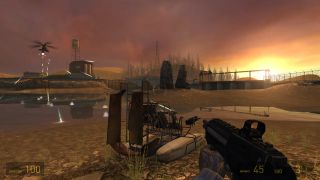
"Making games is hard, and every team has to pick their battles carefully"
Gabe Newell
The team was broken up into cabals, each working on separate areas – but this time art was applied to the levels after their essential geometry had been laid out, with the game's writer, Marc Laidlaw, ducking between groups to ensure everything fitted into the overall fiction. The result was the more cohesive sense of place and tone, which was vital to the projection of Half-Life 2's narrative, and which took a much darker turn than that of the original game.
"This came naturally out of the design of the world," Laidlaw says. "There was no point at which we didn't see the universe as being essentially dark. As long as we were trapped in the confines of Black Mesa, we didn't have to deal with the world beyond those walls, but that didn't mean we pictured a positive, nurturing environment. When the world of Half-Life 2 started coming into focus, we tried to be consistent in tone – but this wasn't a matter of being selectively darker or more sophisticated. It simply meant we had to be vigilant about introducing elements that might inadvertently break the spell we were trying to cast."
There were tonal aspects of Half-Life's world that needed to be reset, however. Although Dr Kleiner and his pet headcrab provide comic relief, HL2 is a much more consistently grim fiction, avoiding the more obvious satirical elements of Half-Life's sci-fi. "We found that satire or parody was too limiting as a fundamental principle for creating a universe rich with possibilities," Laidlaw says.

The first Half-Life: Alyx trailer is the closest we're gonna get to Half-Life 3
Dr Breen, the human stooge of the oppressive Combine, could easily have been a caricatured tyrant, all monocles and Gestapo gloves – but instead his snake oil philosophy is presented in unsettlingly reasonable, measured terms. Even as Breen persuades the occupants of City 17 to reject their base instinct for procreation, his creed is never presented with tongue overtly in cheek. Equally, the casual black humour with which scientists were reduced to offal in the first game is replaced with a much sadder sense of macabre – there is little humour to be found in the cremated corpses lying in gnarled heaps beside derelict coastal buildings. The many and grisly ways in which the player is encouraged to dispatch zombies allows for grim amusement, but elsewhere the humble headcrab is used to tell poignant stories of failed resistance – and the demented wail of a zombie carrying a payload of poison headcrabs is surely one of the most chilling noises in video games.
Did Valve always intend its sequels to mature with the game's audience? Surprisingly not, according to Newell. "That isn't something we think about except as part of each project needing to respect the fact that simply repeating the past isn't going to have the same impact now as it did then," he says. "I feel like we've gotten away from genuinely scaring the player more than I'd like, and it's something we need to think about, in addition to broadening the emotional palette we can draw on." And now, as the future players of Episode Three start having families and hitting middle age, what horrifies them more than anything else? "The death of their children," says Newell. "The fading of their own abilities."
Avoiding cliché
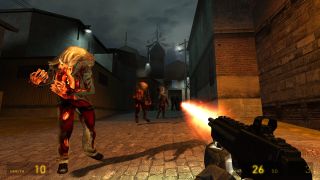
The maturity with which Valve approached its world can be seen not so much in the broad strokes of its plot but in the credible drawing of its environments – instilling a strong sense of place while compounding the game's bleak tone. Though the moonlit zombie-filled Ravenholm makes plenty of knowing nods to the horror genre, Half-Life 2 largely resists the more obvious opportunities to deploy cliché. The bold decision to scrub early ideas for a globe-trotting plot and concentrate the action in a nonspecific eastern European country provided Valve with a fresh and idiosyncratic palette. Nonetheless, the first designs for City 17 and the surrounding wasteland saw them endure the stormy night skies of Gothic horror. The former then had the air of Blade Runner – nocturnal, rain-swept and with the dense entanglement of old and new accelerating decay. Yet the crisp sallow daylight of the final game transforms the environments into something unlike any of its inspirations. The stately plazas of the eastern European city are beset by technology which seeks to order the world as it consumes it, quite apart from Blade Runner's depiction of entropy under flickering neon lights. The towering, angular Combine structures themselves have a fascistic flavour to them – but their alarming asymmetry, impossible distribution of mass and unknowable materials, dark and iridescent, mark them out as something entirely Other.
The wasteland, too, sidestepped scorched-earth cliché and instead opted for a melancholic emptiness. The quiet wood buildings of the coast, like so many of the environments in Half-Life 2, hold stories that unravel as you explore, their hastily assembled possessions and broken makeshift barricades telling of the panic of the occupants' final few minutes. In cooperation with the player, the architecture of the levels themselves becomes narrator, guiding the player through little dramas that expand upon the world's fiction in bullet holes and spraypaint. Prior to Half-Life 2, environments had largely served as prettified backdrops: Quake 2's imposing metal halls and gantries had unsurprisingly little to say about life on Stroggos. Half-Life 2 championed a form of efficient, wordless storytelling that could only work in video games – a medium allowing for that explorative interaction with a 3D space.
It's another boon of this mode of storytelling through the level's physical structure that you need never notice it. Though the coastal sections invite you to stop and wonder at the desolation, it's quite possible to screech through them in your buggy, bouncing from battle to battle. This is necessarily so: the game's successes elsewhere would have been for naught if it was a limp shooter.

"We found that satire or parody was too limiting as a fundamental principle for creating a universe rich with possibilities"
Marc Laidlaw
Half-Life 2's mechanics may feel out of place among the more weighty, embodied shooters of more recent times, but the actual pace of the game and structure of the firefights is still brilliantly conceived. Scripting describes many of these encounters, enemies popping up to harry you during your flight to Black Mesa East, but as the tables turn the player often finds himself engaging the enemy on his own terms. These are fascinating AI encounters: the Combine soldiers flank and probe your defences in ways that are credible yet defeatable. The tripodal Striders hunker down to peer under your cover and, in later episodes, acid-spitting antlions constantly shift their position around, just out of range – AI behaviour which is predictable enough to be countered by a little thought, but organic enough to never feel prescriptive or obvious, dangerous enough that each battle teeters on the limits of your control.
Half-Life 2 manages a sense of ever-increasing empowerment by creating a constant see-saw between threat and your ability to overcome it: mounting the pulse cannon on to the airboat allows you to finally deal – violently, cathartically – with the chopper that has harassed you through City 17's canals; the gravity gun transforms the zombie menace into a grisly playground full of physics-enabled buzz saws and petrol canisters; the antlions go from being a lethal nuisance to your willing minions; and, of course, just when you think the game has stripped you of all your weaponry, it turns the gravity gun into a device of awesome power, able to rip the Combine consoles depicting Breen's face straight from the walls and toss them into a unit of soldiers.
The dynamism of these battles has increased as the episodes have gone on, escalating through the frantic scraps with the dog-like Hunters to the climactic defence of White Forest at the end of Episode Two. But Valve has always been able to manipulate the width of the linear path the player takes. Along with the convincing world-building, it's that balance of moment-to-moment freedom with the urgent motivation to keep moving that prevents it from feeling as confined and claustrophobic as other corridor shooters. Momentum is driven either from behind, by pursuing forces, or by hanging eventual goals on the horizon – making your arrival there that much more significant.
The creation of Alyx

Valve's creatives are masters of understanding how drama can work in an interactive world, in a navigable 3D environment, from seeding narrative into the architecture to carefully guiding the player's eye towards details of significance. But Valve was also among the first developers to breathe life into the people who occupy the place. "We wanted to try our hand at adding real characters to the story, rather than caricatures," Laidlaw says. "Advances in animation, and the people we were luring in from the film industry, spurred us to try for a broader emotional range." Admittedly, Valve's approach to cutscenes has become more obtrusive as the drama it wishes to convey has grown more complex – players can opt out to a degree (Dr Kleiner's laboratory provides many distractions for those uninterested in the plight of Lamarr), but by and large you are confined while the dialogue plays out. Yet it's in your companionship with the characters outside these scenes that they grow on you the most – becoming active participants in the action.
The technical advances have continued, but still only a small handful of video game buddies are as good company as Alyx; an even smaller number of female characters in games have been as appealing (and an even smaller number aren't Caucasian). Alyx is something of a video game Suffragette, to whose efforts the Elena Fishers of the world owe a debt. Certainly, there's a palpable frisson of love interest, but the highly capable, geeky Alyx is speaking to an entirely different audience – one for whom romantic aspirations have evolved beyond locating dad's Playboy stash. Was there ever any doubt at Valve about whether the audience was ready for a female role as something other than pixellated titillation?
"We never argued about Alyx," says Laidlaw. "In a lot of ways, the personality of the character in the game is just a refined version of our initial vision. Every discussion was about giving her more depth, more believability; we were all moving in the same direction from the start. Just as we wanted Gordon to be easily distinguishable from the typical video game heroes of the day, we wanted Alyx to stand apart from the video-babe clichés."
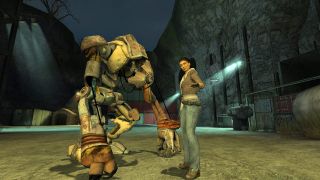
"Every discussion was about giving her more depth, more believability; we were all moving in the same direction from the start"
Marc Laidlaw
While Alyx and the supporting cast have aged well, going back to Half-Life 2 now, one of the few things that feels a little quaint is Freeman's inability to speak. Latter-day games, even shooters, either tend to impose vocalisations upon the protagonist or give the player some options for expression. But would Valve ever want Half-Life 2's hero to speak? "Gordon Freeman, whatever his strengths and weaknesses, is defined entirely by his design constraints," Laidlaw says. "Silence is the keystone of his character. I know it doesn't work for everyone, but fortunately there are plenty of games with talking protagonists. We don't have to turn Half-Life into one of those.
That said, the 'strong, silent type' jokes are way past their expiration date. Even the very first and freshest one was slightly curdled." Newell seems more open to the idea. "We're not philosophically opposed to this," he says, "but we don't have good reasons to do it. Right now making your companions more interesting and compelling seems a more fruitful avenue to explore." But Newell's less enamoured by our suggestion that Gordon might one day get a greater sense of embodiment – to become more than a floating hand and crowbar: "We haven't had a reason to change that. Most of what I've seen to date has been gimmicky and is entertaining for just a minute or so."
Despite such assurances to the contrary, we wonder if Valve's dogmatic insistence on producing episodes, rather than an outright sequel, has left it strapped to conventions that it would rather leave behind. But even if it resists any mechanical change for the upcoming Episode Three, the series will still stand as the high point of what the first-person shooter has achieved in terms of narrative and world-building, its aftershocks still rattling through any game that attempts to tell a story within a 3D space. But it's more than understanding how to use the medium: when we look back and smirk at how gaming's early days were bootstrapped by puerile fantasy and thoughtless violence, when the first-person shooter finally involves considerably more than just shooting, it will be Half-Life 2 to which everyone owes the debt.
This feature first appeared in EDGE. For more excellent articles like the one you've just read, why not subscribe to the print or digital edition of EDGE Magazine at MyFavouriteMagazines.
Edge magazine was launched in 1993 with a mission to dig deep into the inner workings of the international videogame industry, quickly building a reputation for next-level analysis, features, interviews and reviews that holds fast nearly 30 years on.
Most Popular



